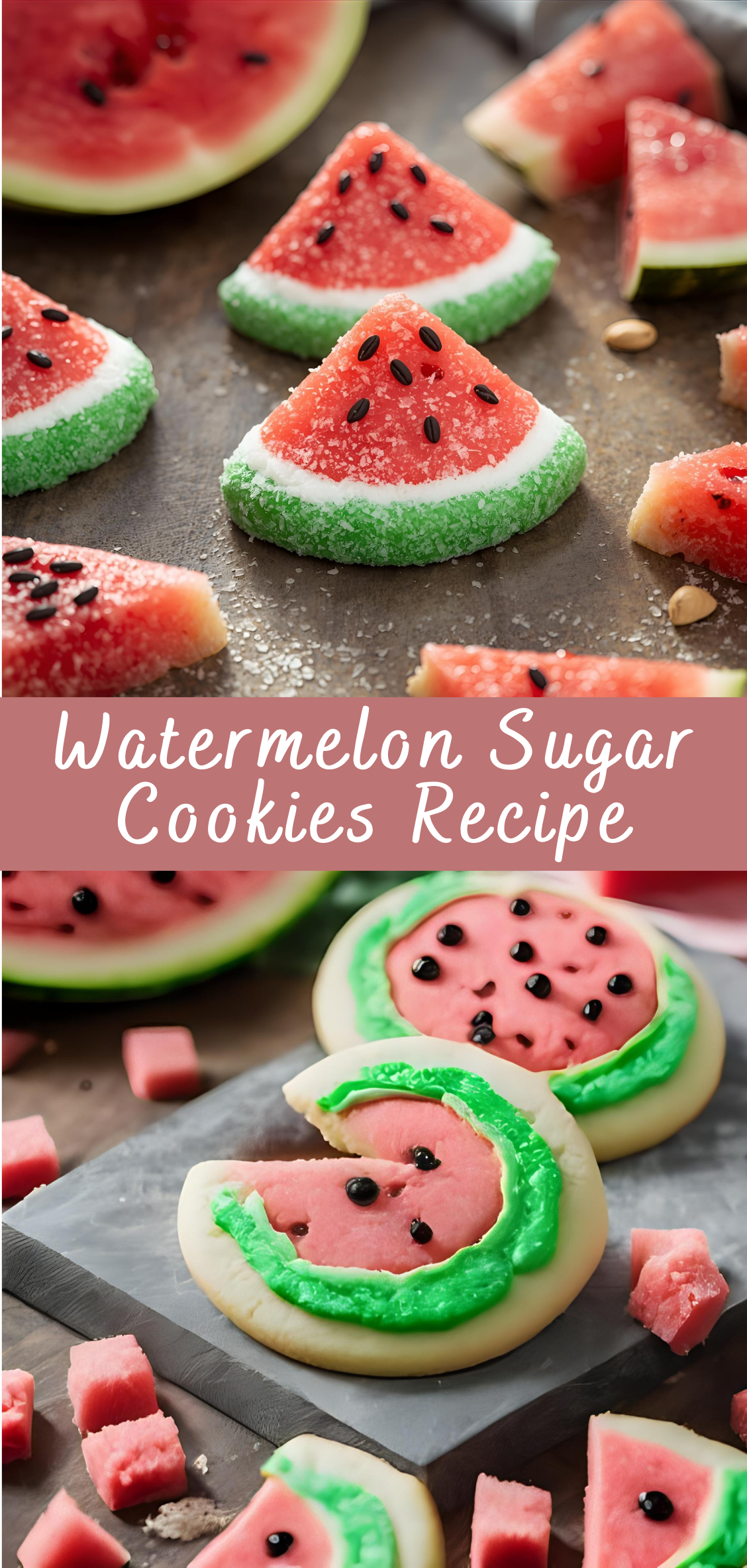A Whimsical Taste of Summer – Watermelon Sugar Cookies
There’s something inherently joyful about watermelon. It’s the quintessential summer fruit—juicy, vibrant, refreshing, and nostalgic. For many, the sweet scent of watermelon evokes memories of sun-drenched afternoons, picnics on freshly cut grass, and sticky fingers that linger long after the last bite. Now imagine capturing that very essence in a soft, buttery cookie—playful in both flavor and appearance. That’s exactly what Watermelon Sugar Cookies promise to deliver.

More than just a seasonal treat, these cookies are a celebration of creativity and whimsy. Their vivid pink centers, flecked with mini chocolate chip “seeds,” bordered by a ring of green icing or dough, instantly evoke the image of a freshly sliced watermelon. But while their aesthetic is charming, their flavor and texture are what truly make them memorable. Think of a melt-in-your-mouth sugar cookie, delicately infused with subtle watermelon essence—sweet, light, and unexpected.
Watermelon Sugar Cookies are the kind of dessert that catches the eye and holds attention. They’re the star of any summer dessert table, a conversation starter at birthday parties, and a delightful surprise in lunchboxes or gift tins. They’re as fun to make as they are to eat, inviting bakers of all levels to get creative with color, shape, and presentation. Whether you’re baking with children, preparing for a themed event, or simply indulging a seasonal craving, this recipe offers a chance to explore your culinary imagination.
But these cookies aren’t just about aesthetics. Behind their whimsical appearance is a carefully tested recipe that balances flavor, texture, and visual appeal. The base dough is soft yet sturdy, perfect for slicing or shaping. The hint of watermelon extract adds a unique twist without being overpowering, and the choice of chocolate chips as “seeds” introduces a contrasting richness that pairs beautifully with the cookie’s sweetness. The green rind—whether achieved through colored dough or a simple glaze—adds a final touch of realism that makes these cookies truly unforgettable.
In this comprehensive guide, we’ll walk you through everything you need to know to master the art of Watermelon Sugar Cookies. From ingredients and substitutions to dough preparation, coloring techniques, flavor balancing, baking times, decorating tips, storage solutions, and creative variations—you’ll find it all here. Whether you’re an experienced home baker or a curious beginner, this tutorial is designed to help you succeed and enjoy every step of the process.
Before we dive into the recipe itself, we’ll also explore the history and evolution of sugar cookies, why watermelon flavoring has become increasingly popular in modern baking, and how these two beloved elements come together in one delightful dessert. You’ll also learn about the science behind sugar cookie dough—why certain ingredients are used, how different techniques affect texture, and what to watch out for to avoid common pitfalls.
So get ready to preheat your oven, dust off your mixing bowls, and embrace the vibrant world of watermelon-inspired baking. These Watermelon Sugar Cookies aren’t just a treat—they’re an experience, a memory in the making, and a sweet slice of summertime joy.
Ingredients and Equipment for Watermelon Sugar Cookies
Before we start baking, it’s essential to have all your ingredients measured and tools ready. Preparation is the backbone of successful baking, especially when working with colored dough and decorative cookies like these.
A. Ingredients
For the Cookie Dough:
-
3 cups (360g) all-purpose flour, sifted
-
1 teaspoon baking powder
-
½ teaspoon salt
-
1 cup (226g) unsalted butter, softened to room temperature
-
1¼ cups (250g) granulated sugar
-
1 large egg, room temperature
-
2 teaspoons pure vanilla extract
-
1 teaspoon watermelon extract (see note below)
-
Pink/red gel food coloring (avoid liquid coloring to prevent altering dough consistency)
-
Green gel food coloring (for the rind section)
-
Miniature semi-sweet chocolate chips (these will serve as the “seeds”)
Note: Watermelon extract can be found in specialty baking stores or online. If you prefer, you can substitute it with another complementary extract like strawberry or leave it out for a classic sugar cookie flavor.
For Decorating (Optional):
-
Royal icing or glaze for outlining and detail
-
White sanding sugar for texture on the rind (optional)
-
Black sugar pearls or edible ink pen (for precise “seeds” as an alternative to chocolate chips)
B. Equipment Needed
-
Stand mixer or hand mixer
-
Large mixing bowls
-
Rubber spatula or silicone scraper
-
Measuring cups and spoons
-
Digital kitchen scale (recommended for precision)
-
Plastic wrap or parchment paper
-
Rolling pin
-
Sharp knife or dough cutter
-
Baking sheets
-
Silicone baking mat or parchment paper
-
Wire cooling rack
-
Small offset spatula (optional)
-
Gel food coloring
-
Toothpicks (for precise color mixing)
-
Bench scraper (optional, but useful for shaping)
-
Small piping bags and tips (for decorating, optional)
Step-by-Step Instructions
Let’s dive into the baking process. Take your time with each step. This isn’t a rush job—it’s about enjoying the creative process and producing something truly delightful.
Step 1: Prepare the Dry Ingredients
In a medium-sized bowl, whisk together:
-
3 cups of all-purpose flour
-
1 teaspoon of baking powder
-
½ teaspoon of salt
Tip: Always sift your flour if it looks clumpy, especially if you live in a humid area. This helps avoid pockets of flour in the dough and ensures even mixing.
Set this dry mixture aside for later.
Step 2: Cream the Butter and Sugar
In a large mixing bowl (or the bowl of a stand mixer):
-
Add 1 cup of softened unsalted butter.
-
Beat on medium speed for about 1 minute until smooth and creamy.
-
Add in 1¼ cups of granulated sugar.
-
Continue beating for 2–3 minutes, until the mixture is light in color and fluffy in texture.
Why this matters: Creaming the butter and sugar incorporates air into the mixture, helping your cookies rise slightly and creating a soft, tender crumb.
Step 3: Add Egg and Extracts
-
Crack in 1 large egg and beat on low until fully incorporated.
-
Add 2 teaspoons of vanilla extract and 1 teaspoon of watermelon extract.
-
Mix again until well blended.
Tip: If using natural extracts or oil-based flavorings, start small and taste-test the dough (before adding the egg, if preferred). Watermelon flavor can quickly become artificial if overused.
Step 4: Combine Wet and Dry Ingredients
-
Slowly add the dry ingredient mixture into the wet mixture in three batches.
-
Mix on low speed to avoid flour flying everywhere.
-
Scrape down the sides of the bowl with a spatula between each addition.
The final dough should be soft, pliable, and just slightly sticky but not wet.
Step 5: Divide and Color the Dough
Now comes the fun part—adding color to mimic the look of watermelon.
A. Divide the Dough:
-
60% of the dough will become the pink/red center (flesh)
-
35% will become the green outer ring (rind)
-
5% can remain uncolored or be dyed a lighter green or white to mimic the pith (optional)
B. Color the Dough:
-
Take the largest portion and add pink or red gel food coloring a little at a time. Mix until evenly colored.
-
Take the green portion and color it similarly using green gel food coloring.
-
Optional: Leave a small portion uncolored or add just a hint of ivory/green for the rind’s inner line.
Important: Always start with a tiny amount of gel coloring and build up. Dough color can deepen slightly as it rests.
Step 6: Incorporate the Chocolate “Seeds”
Take the pink/red dough and gently knead in ¼ to ½ cup of mini chocolate chips. These mimic watermelon seeds.
Tip: If you’re rolling the dough into a log, ensure the chips are evenly distributed but not near the surface, as they can burn.
Step 7: Shape the Dough into Logs or Slices
There are two shaping options for your cookies:
Option 1: Log-Shaped Watermelon Wedges
-
Roll the pink/red dough into a thick log, about 2 inches in diameter.
-
Wrap it in plastic and chill it for 15–20 minutes to firm up.
-
Roll out the green dough into a flat sheet.
-
Wrap the green dough around the pink log to form the outer rind.
-
Roll it gently to smooth out any seams.
-
Chill for 1 hour until completely firm.
Once chilled, you can slice the log into ¼-inch thick discs. To create watermelon “slices,” cut each disc in half into a wedge shape.
Option 2: Roll-and-Cut Sugar Cookies
-
Roll out the pink dough to about ¼-inch thickness.
-
Use round or half-moon cookie cutters to create “slice” shapes.
-
Use the green dough to create a rind edge along one curve.
-
Press the pieces together gently and use a bench scraper to straighten edges.
-
Add chocolate chips if not already incorporated.
Step 8: Chill the Shaped Cookies
Before baking, chill your shaped cookies in the refrigerator for 20–30 minutes.
Why chill again? Cold dough holds its shape better in the oven and prevents excessive spreading.
Step 9: Bake the Cookies
-
Preheat your oven to 350°F (177°C).
-
Line baking sheets with parchment paper or silicone mats.
-
Place chilled cookies on the sheet, leaving about 2 inches between each.
-
Bake for 10–12 minutes, depending on size.
Don’t overbake. The cookies should be just set around the edges and still soft in the center. They will firm up as they cool.
Step 10: Cool Completely
-
Allow cookies to cool on the baking sheet for 5 minutes.
-
Transfer to a wire rack to cool completely before decorating or storing.
Step 11: Optional Decoration
If you want to enhance the look:
-
Outline the rind with green royal icing.
-
Add a layer of white sanding sugar to the rind for texture.
-
Use black sugar pearls or an edible marker to make precise seed shapes.
Let all icing decorations dry fully before storing.
Watermelon Sugar Cookies Recipe
There’s something inherently joyful about watermelon. It’s the quintessential summer fruit—juicy, vibrant, refreshing, and nostalgic. For many, the sweet scent of watermelon evokes memories of sun-drenched afternoons, picnics on freshly cut grass, and sticky fingers that linger long after the last bite. Now imagine capturing that very essence in a soft, buttery cookie—playful in both flavor and appearance. That’s exactly what Watermelon Sugar Cookies promise to deliver.
Ingredients
- For the Cookies:
- 2 ¾ cups all-purpose flour
- 1 teaspoon baking soda
- ½ teaspoon baking powder
- ½ teaspoon salt
- 1 cup (2 sticks) unsalted butter, softened
- 1 ½ cups granulated sugar
- 1 large egg
- 1 teaspoon vanilla extract
- ½ teaspoon watermelon extract (optional, for flavor)
- Red or pink gel food coloring
- Mini chocolate chips (to mimic watermelon seeds)
- Green food coloring (for rind decoration, optional)
- Additional granulated sugar for rolling (optional)
- For Decoration (Optional):
- Royal icing or colored frosting (green and white)
- Pink sanding sugar
Instructions
- Preheat oven to 350°F (175°C). Line baking sheets with parchment paper or silicone mats.
- Mix dry ingredients:
In a medium bowl, whisk together flour, baking soda, baking powder, and salt. Set aside. - Cream butter and sugar:
In a large bowl, beat butter and sugar together with an electric mixer until light and fluffy (about 2–3 minutes). - Add egg and flavoring:
Beat in the egg, vanilla extract, and watermelon extract (if using). Mix until combined. - Add food coloring:
Add red or pink food coloring gradually until you reach a watermelon-like hue. - Combine dry ingredients:
Slowly mix in the dry ingredients just until combined. Do not overmix. - Fold in chocolate chips:
Gently stir in mini chocolate chips to resemble watermelon seeds. - Chill dough (optional but recommended):
Cover and chill dough for 30–60 minutes for easier handling and better shape retention. - Shape the cookies:
Scoop about 1 tablespoon of dough, roll into a ball, then flatten slightly. For a watermelon slice effect, shape dough into a disk or semi-circle. Press extra chocolate chips on top if desired. - Decorate (optional):
You can roll the edges in green sugar, or once baked and cooled, pipe green and white icing on the curved edge to mimic a watermelon rind. - Bake:
Bake for 8–10 minutes, or until the edges are just beginning to turn golden. Do not overbake. - Cool:
Let cookies cool on the pan for 5 minutes before transferring to a wire rack.
Notes
- Watermelon extract adds a fun twist but can be omitted or replaced with strawberry extract for a fruity touch.
- For more authentic “seeds,” press a few mini chocolate chips on top after baking while cookies are still warm.
- If decorating with icing, wait until cookies are fully cooled.
- For slice-style cookies, you can shape the dough into a log, chill, and cut into slices before baking.



